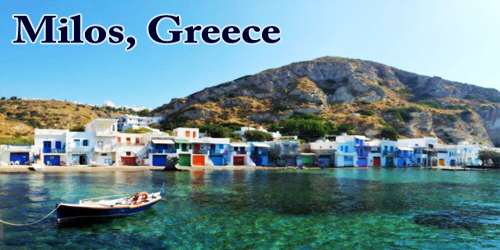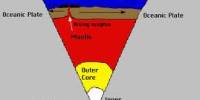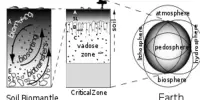Milos or Melos (/ˈmɛlɒs, -oʊs, ˈmiːlɒs, -loʊs/; Modern Greek: Μήλος (ˈmilos); Ancient Greek: Μῆλος Melos) is one of the volcanic Greek islands, sitting at the southernmost part of the Cyclades island complex. It is known as the “island of color” due to the varying rock formations that make up the island.
The Venus de Milo (now in the Louvre) and the Asclepius of Milos (now in the British Museum) were both found on the island, as were a Poseidon and an archaic Apollo now in Athens. Milos is a popular tourist destination during the summer. The municipality of Milos also includes the uninhabited offshore islands of Antimilos and Akradies. The combined land area is 160.147 square kilometers (61.833 sq mi) and the 2011 census population was 4,977 inhabitants.
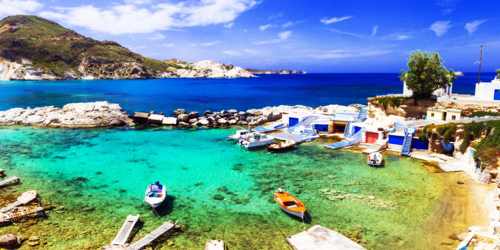
The volcanic activity in ancient years has endowed Milos island with an exciting variety of gorgeous landscapes, consequently offering the visitor a wide range of activities. The funny shapes of the rocks and their wonderful colors at the beautiful white sandy beaches are one expression of the volcanic features of Mílos; the economic activity is another: minerals such as obsidian are excavated here. What is more, one of the most ancient mines in the Mediterranean is on this island.
There are about 70 beaches found throughout Milos that can be explored during your water journey. Due to the abundance of beaches, the most popular activities are centered around the water. Sea kayaking, sailing, snorkeling, scuba diving, and windsurfing are all popular options around Milos.
The island’s villages are lovely too: the stately Pláka (the island’s capital), the harbor of Adámantas, the beautiful Hivadolímni, the marvelous Emporiós with the little lagoon of Revary and the old iron mines. As far as archaeology is concerned, Mílos is an ideal destination: the early Christian catacombs, a prehistoric settlement in Fylakopi, and the mining museum (exhibiting 11,000 years of mining history) are definitely worth a visit.
Obsidian (a glass-like volcanic rock) from Milos was a commodity as early as 15,000 years ago. Natural glass from Milos was transported over long distances and used for razor-sharp “stone tools” well before farming began and later: “There is no early farming village in the Near East that doesn’t get obsidian”. The mining of obsidian did not lead to the development of permanent habitation or manufacturing on the island. Instead, those in search of obsidian arrived by boat, beaching it in a suitable cove and cutting pieces of the volcanic glass from the quarries.
Milos is the most Western island of the Cyclades (Cyclades islands forming a circle), in Greece. It has about 6,000 inhabitants scattered over seven small towns (like Adamas, Plaka, and Tripitì). The island is ample, due to the very large and beautiful gulf which is in the very middle of it and which gives the island a horseshoe shape. Milos surface is 151 km2 with a coastline of 120 km.
The position of Milos, between mainland Greece and Crete, and its possession of obsidian, made it an important center of early Aegean civilization. Milos lost its arms-making importance when bronze became the preferred material for the manufacture of weapons.
Melos was one of the first islands to join the Greek War of Independence of 1821. During the 19th century, Melos was a major rendezvous point for American and British ships fighting Muslim pirates in the Mediterranean. In February 1943, 14 male civilians were executed for collecting material owned by the Wehrmacht that was washed up after the sinking of a German cargo ship by Allied aircraft. The population peaked in 1928 at 6,562 people. In 2011 it was 4,977.
Like the rest of the cluster, the island is of volcanic origin, with tuff, trachyte, and obsidian among its ordinary rocks. The natural harbor is the hollow of the principal crater, which, with a depth diminishing from 70 to 30 fathoms (130–55 m), strikes in from the northwest so as to separate the island into two fairly equal portions, with an isthmus, not more than 18 km (11 mi) broad. In one of the caves on the south coast, the heat from the volcano is still great, and on the eastern shore of the harbor, there are hot sulfurous springs.
Antimelos or Antimilos, 13 miles (21 km) north-west of Milos, is an uninhabited mass of trachyte, often called Erimomilos (Desert Milos). Kimolos, or Argentiera, 1.6 km (0.99 mi) to the north-east, was famous in antiquity for its figs and fuller’s earth and contained a considerable city, the remains of which cover the cliff of St. Andrew’s. Polyaigos (also called Polinos, Polybos or Polivo alternative spelling Polyaegos) lies 2 km (1 mi) south-east of Kimolos. It was the subject of dispute between the Milians and Kimolians. It is now uninhabited.
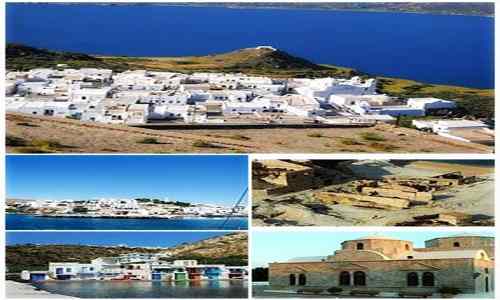
In Milos island, there are more than 70 beaches, each one with its own characteristic and beauty. This is why Milos offers an interesting and unforgettable vacation: you may change beaches every day and never be bored. The luckier people with boats (“sailors”) will reach waters of blue, azure, emerald, green, red, and violet colors contrasting with white or pink, or red rocks. It is really the Island of Colors. All the colors of the rainbow. Visitors may see all these colors on a single spot at some places along the coasts of the island. The nearby satellite islands, Kimolos and Polyaigos, also have secluded beaches and landscapes of great beauty.
The months of April and May are ideal to see the island blooming, to smell its keen perfumes, and to ride around in the exceptional road network to see a unique wild landscape. In September and October the color of the sea, the beautiful sunsets, and a gentle breeze give Milos Island a calm atmosphere and allows a very restful vacation.
On the island Visitors or travelers will mostly find family-run guesthouses; the big and luxurious five-star hotels have only established their presence over the last years. Visitors or travelers can also choose to stay in one of the traditional colorful houses by the sea, the so-called “sýrmata”, mostly found on the settlements of Klýma, Madrákia, Mýtakas, and Fyropótamos.
While a lesser-known island within the extremely popular Cyclades archipelago, Milos has grown in popularity as a vacation destination in the past several decades. With its traditional Greek architecture, slower pace compared to Santorini and Mykonos and varied beaches. Milos rose in international recognition following the popularity of a work by famous spoken-word poet, Anis Mojgani entitled Milos which is rich in allusions to Greek mythology and artwork that made the island significant.
Milos is much less crowded than the more popular Greek Islands of Santorini and Mykonos. For a true Greek cultural experience with all the beauty of the famed Greek islands, head to Milos!
Information Sources:
